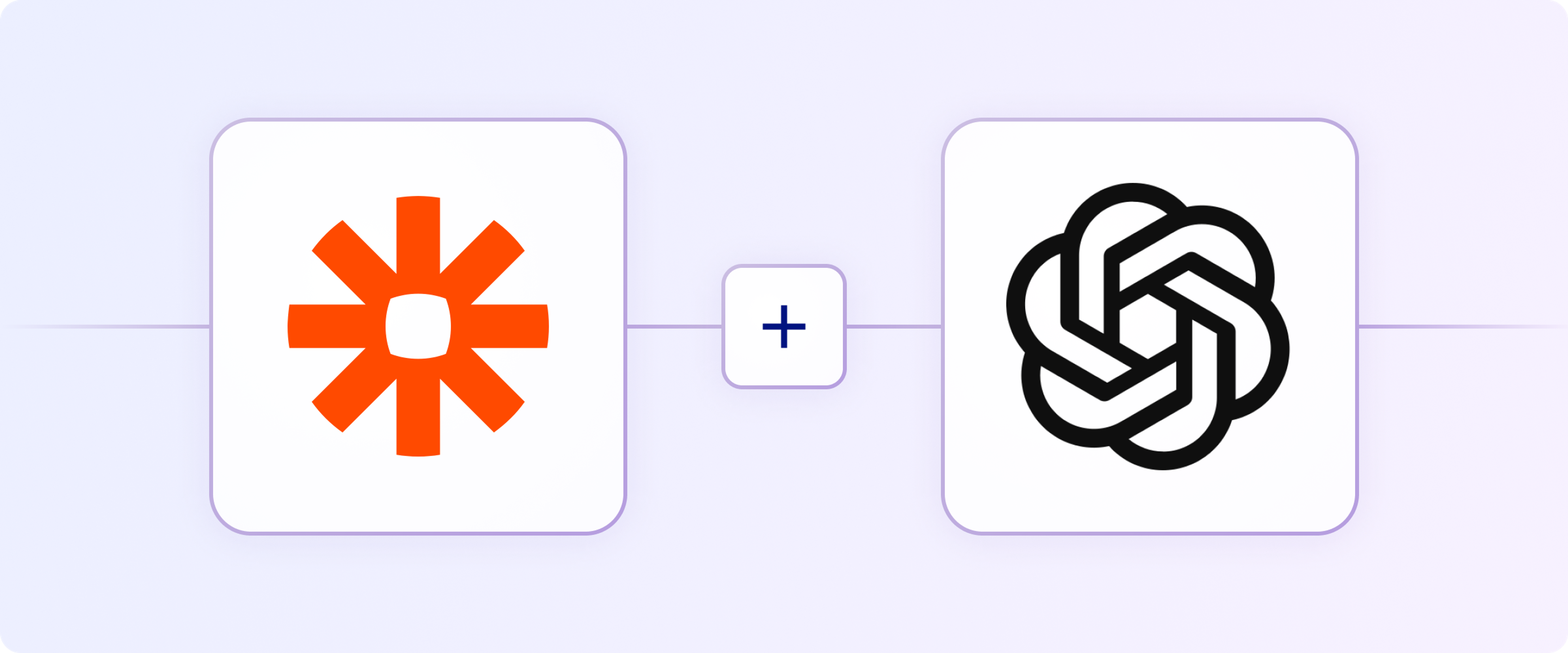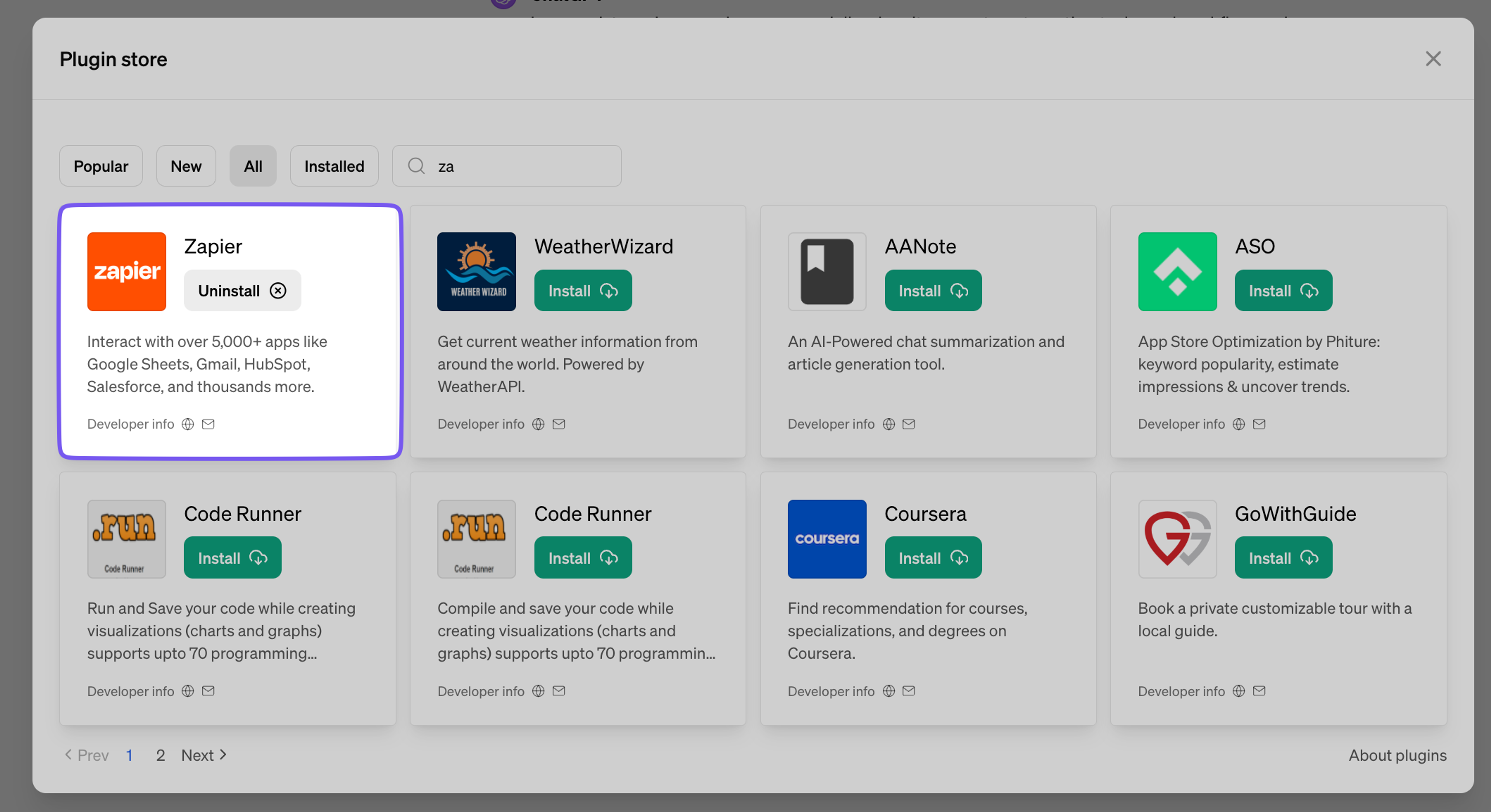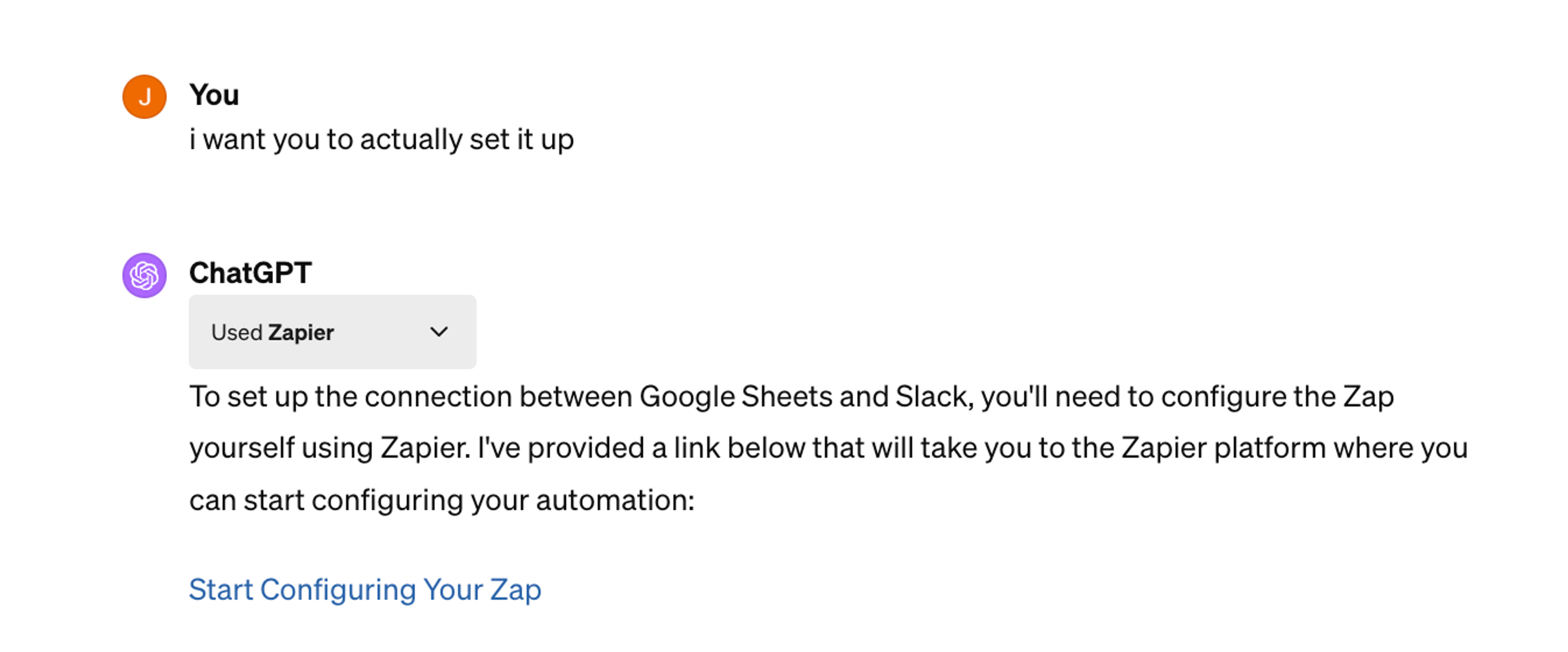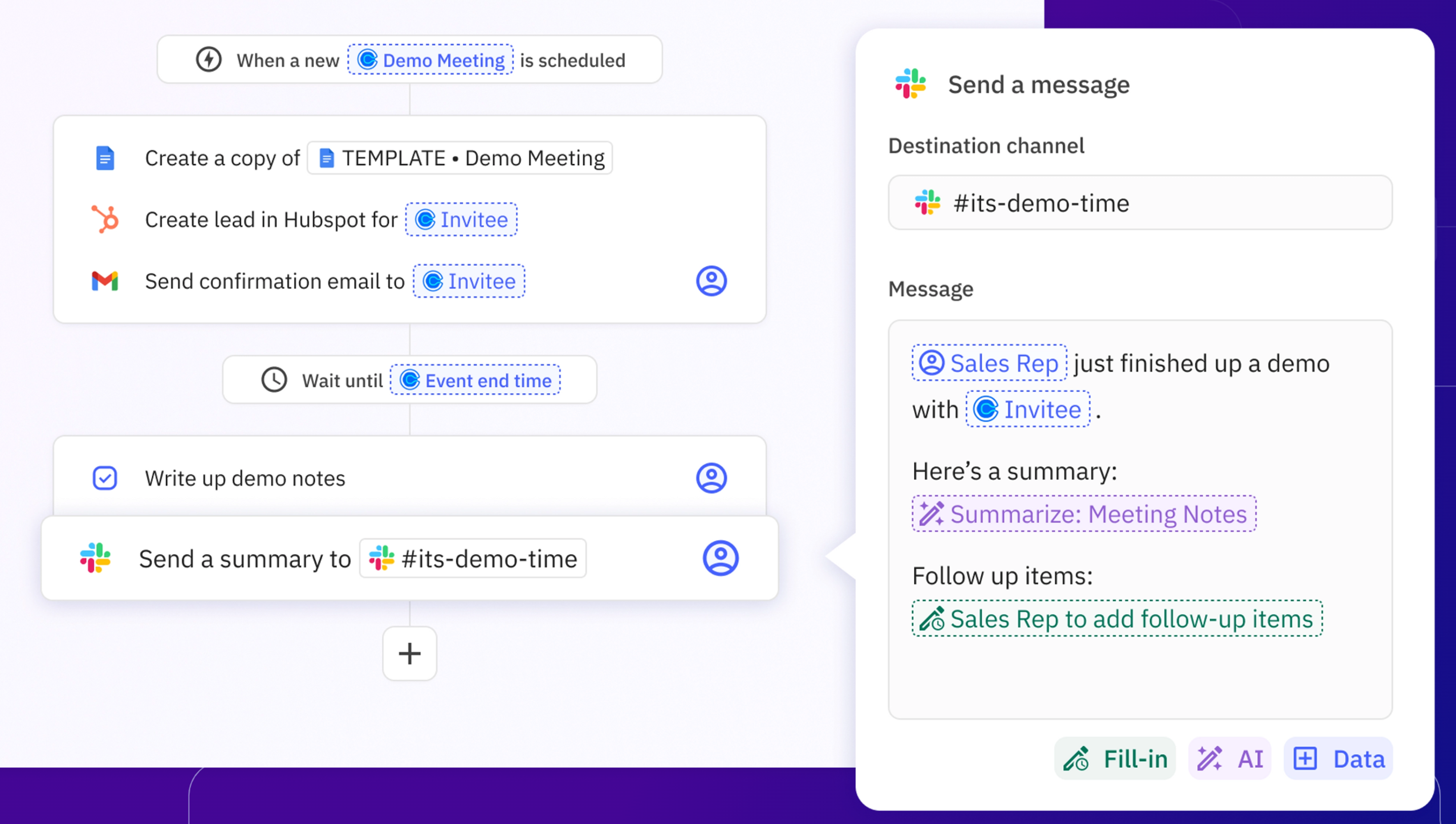
Combining the conversational intelligence of ChatGPT with the connective power of Zapier opens up a world of possibilities.
Whether you're looking to automate responses, generate content, or streamline workflows, integrating ChatGPT with Zapier can provide sophisticated solutions. Let's look at how it works.
What is the Zapier ChatGPT plugin?

The Zapier ChatGPT plugin allows users to easily connect with over 5,000 apps like Google Sheets, Gmail, or Slack through ChatGPT and Zapier's automation platform. This plugin is compatible with all Zapier plans and is being made available to users with a ChatGPT Plus account.
How does the Zapier ChatGPT plugin work?
Powered by Zapier's Natural Language Actions API, this plugin enables ChatGPT to understand and execute actions in other apps using simple, natural language commands (at least in theory).
Whether it's sending an email, updating contacts in a CRM, or adding rows to a spreadsheet, the process is streamlined into conversational commands that ChatGPT translates into actions.
Here's how to get started with the Zapier ChatGPT plugin:
1. Sign up for a ChatGPT Plus account: To access the Zapier ChatGPT plugin, you'll need a ChatGPT Plus account. Visit the OpenAI website to sign up for an account if you don't already have one.
2. Set up a Zapier account: If you don't already have a Zapier account, sign up for one on the Zapier website. Choose a plan that best fits your needs, as the availability of certain features may vary depending on your plan.
3. Connect ChatGPT with Zapier: Once you've gained access to the Zapier ChatGPT plugin, follow the instructions provided to connect your ChatGPT Plus account with your Zapier account. This will enable seamless communication between ChatGPT and Zapier.
4. Add actions: Now you have to set up individual actions you want ChatGPT to execute on. This is like a mini version of Zapier within ChatGPT. Search for your actions, and connect the accounts...
5. Configure automations: Yep, you'll actually have to leave ChatGPT to configure the workflow trigger and actions. Kind of defeats the purpose, doesn't it?
Popular Zapier/ChatGPT use cases
The Zapier ChatGPT plugin opens up a myriad of possibilities for automating tasks across various domains such as marketing, sales, and IT, through a straightforward interface—and thousands of apps. Some compelling use cases include:
- Communicating with teams: Drafting and sending messages or updates to a shared team channel on Slack.
- Engaging with prospects: Generating and sending personalized emails to leads based on the latest interactions or inquiries.
- Managing databases: Searching, adding, or updating items within a database like Notion directly through ChatGPT prompts.
Drawbacks of the Zapier ChatGPT plugin
1. You're dependent on the ChatGPT interface
One of the main drawbacks of the Zapier ChatGPT plugin is its reliance on the ChatGPT interface for all interactions and automations. (While you can use OpenAI as a connector just like any other app, the main focus is on using Zapier through ChatGPT itself).
This can be seen as a limitation in several ways:
1. For some users, managing tasks directly through the ChatGPT interface may be less intuitive or more cumbersome compared to using the native interfaces of the apps themselves. The conversational format, while innovative, might not always be the most efficient way to perform complex tasks or manage detailed workflows.
2. The plugin's effectiveness is contingent on the quality and specificity of user prompts. In scenarios where tasks require intricate detail or multiple steps, the conversational interface may introduce complexity, making it difficult to convey the exact requirements or to correct misunderstandings without starting over.

For example, during our tests we frequently had to prompt ChatGPT multiple times to do simple actions. Often it would output an explanation of how to do something, instead of actually just doing it. And even when it understood we were trying to execute an automation, it just gave us a link to a Zapier template.
3. You'll need to familiarize yourself with crafting prompts that effectively communicate your desired actions to ChatGPT. This learning curve can be steep for those not already accustomed to interacting with AI.
2. Performance and response times
Executing tasks through the ChatGPT interface may introduce latency compared to using the apps directly. This is due to the time taken for ChatGPT to process the request, perform the action via Zapier, and then relay any response back to the user.
The plugin's performance is also subject to the API rate limits of ChatGPT and the connected apps. High volume usage or complex requests could potentially lead to throttling or temporary blocks, impacting workflow continuity.
3. Access and availability
Currently, access to the Zapier ChatGPT plugin is limited to users with a ChatGPT Plus account. This requirement may exclude a significant portion of the user base, particularly individuals and small businesses operating on a tight budget.
On top of that, the creation of new conversations with plugins will be disabled on March 19, 2024, and users will be able to continue existing plugin conversations until April 9, 2024.
For users currently relying on the Zapier ChatGPT plugin, this transition necessitates exploring alternative solutions or adapting to the new GPT-focused ecosystem. It’s essential to begin planning for this change to ensure a smooth transition and continued productivity.
Relay—a better alternative for AI-powered automation

While the Zapier ChatGPT plugin offers innovative ways to integrate AI into your workflows directly within the ChatGPT interface, it's not the only solution for those looking to enhance their automation with AI capabilities. For users seeking an alternative that offers AI assistance seamlessly integrated into automation workflows, Relay presents a compelling option.
Relay steps into the realm of workflow automation with a focus on integrating AI tools directly into your automation processes, eliminating the need for manual intervention or the crafting of custom prompts. Here’s how Relay enhances your automation workflows with AI:
- No custom prompts needed: Unlike solutions that require you to manually formulate and enter specific prompts to initiate AI-driven tasks, Relay’s AI tools are designed to work autonomously within your workflows. This means less time spent on prompt engineering and more time focusing on results.
- AI-powered data extraction and summarization: Relay comes equipped with AI functionalities that can automatically extract or summarize data critical for your operations. Whether it's parsing through emails, documents, or web content, Relay’s AI can intelligently process and condense information, making it readily usable in subsequent steps of your workflow.
- Intelligent path selection: One of Relay’s standout features is its ability to use AI for making decisions within your workflows. Based on the data at hand, Relay’s AI can intelligently determine which path an automation should follow, adding a layer of decision-making that can dynamically adapt to the information being processed.
Why consider Relay over Zapier for AI-integrated workflows?
- Simplicity: Relay simplifies the integration of AI into workflows by automating the complex parts of the process. This makes it accessible to users without technical expertise in AI or programming.
- Efficiency: By automating data extraction, summarization, and decision-making, Relay enhances the efficiency of workflows, reducing the need for manual oversight and enabling faster completion of tasks.
- Flexibility: Relay's AI tools are designed to be versatile, making them suitable for a wide range of applications, from customer support and sales to HR and IT operations.
- + Cost-efficiency: While we're on the topic, Relay offers an upfront pricing structure that doesn't punish you for creating more automation—just a single fee each month, no matter how many triggers or actions or runs you use, unlike Zapier's usage-based model that can balloon out depending on your use.
For more information, check out our in-depth breakdown of Relay vs Zapier.
Getting started with Relay
By providing AI tools directly where they're needed in your automations, Relay not only streamlines the process but also unlocks new potentials for intelligent workflow management.
Whether you're an existing user of ChatGPT looking for alternative ways to incorporate AI into your automations, or you're new to the concept of AI-driven workflow automation, exploring Relay could be the next step in your journey towards more efficient, intelligent automation solutions.
Get started with Relay's free plan today.
Related reading
